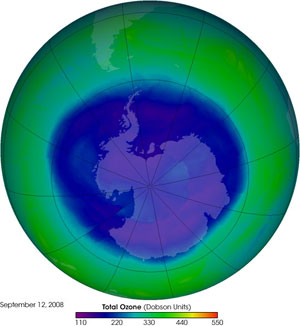Ozone hole is second-largest on record in 2008
mongabay.com
October 30, 2008
|
|
The Antarctic ozone hole reached its second-largest size on record in 2008, reports NASA.
At its maximum size for the year, the “hole” — an area of the stratosphere where the concentration of ozone falls below a certain thinness (220 Dobson units) — covered about 27 million square kilometers, an area larger than North America. The record of 28 million square kilometers was set in 2006. The hole, which has been forming on a seasonal basis over Antarctic since the mid-1980s, is largest around late September.
 On September 12, 2008, the Antarctic ozone hole reached its maximum size for the year. Represented by blues and purples in this image from the Ozone Monitoring Instrument (OMI) on NASA’s Aura satellite, the ozone hole covered about 27 million square kilometers, making it larger than North America, which is about 25 million square kilometers. Though larger than it was in 2007, the 2008 ozone hole was still smaller than the record set in 2006. Image courtesy NASA’s Ozone Hole Watch. |
Ozone depletion is caused by release of ozone-destroying chemicals — including chlorofluorocarbon (CFC) compounds known as “freons” and bromofluorocarbon compounds known as Halons — into the atmsophere. In 1987, following the discovery of their culpability in ozone depletion, the international community adopted the Montreal Protocol which banned the production of CFCs and halons as well as related ozone-depleting chemicals. The move has helped slow the growth of the ozone hole as well as prevented the release of potent greenhouse gases other than CO2. Still scientists say the ozone layer is not expected to recover until 2068.
Contrary to popular opinion, the ozone layer is not the cause of global warming. In fact, scientific observations suggest the ozone hole may promote cooling. As such, the recovery of the ozone layer over Antarctica — the continent which has seen the last warming over recent decades — may speed local temperature rise.
Because the ozone layer prevents most harmful UVB wavelengths of ultraviolet light from entering the Earth’s atmosphere, ozone depletion is a significant concern. Increased penetration by UVB wavelengths of ultraviolet light is believed to heighten the incidence of skin cancer, damage plants, and reduce ocean plankton populations.